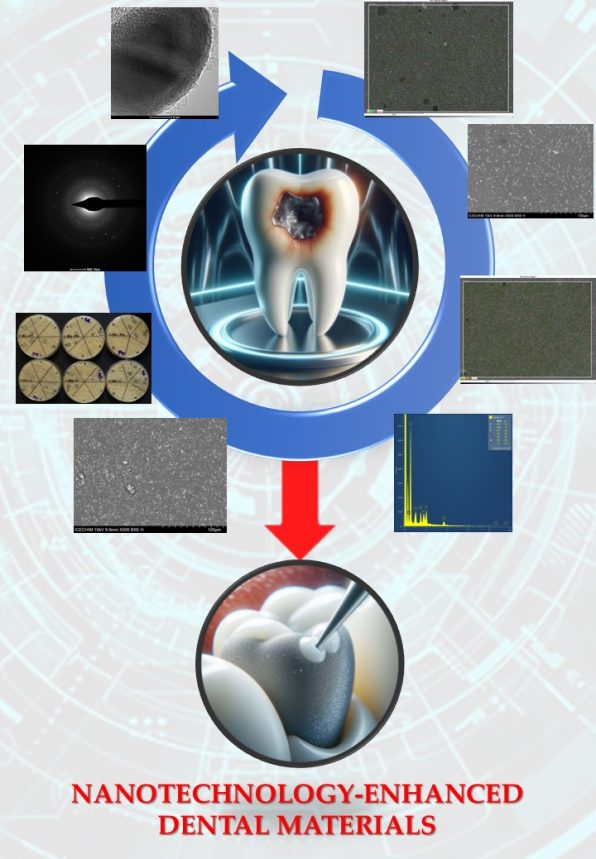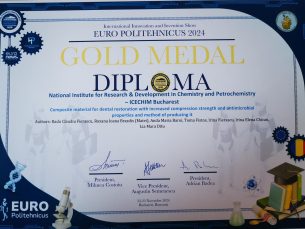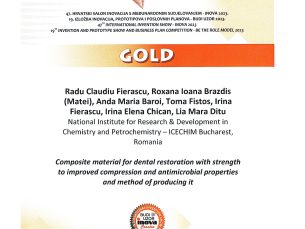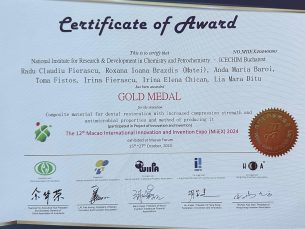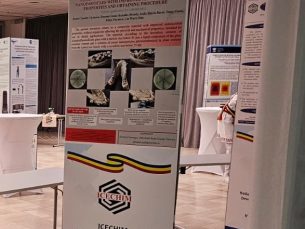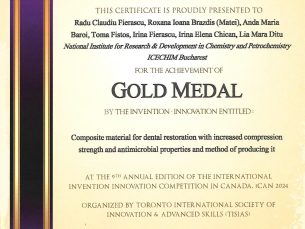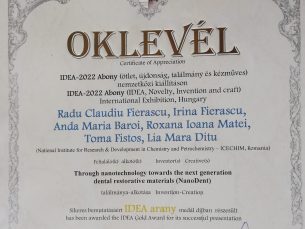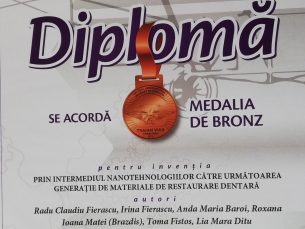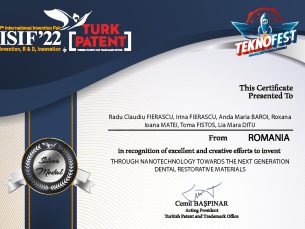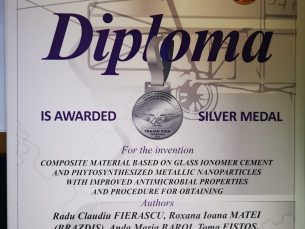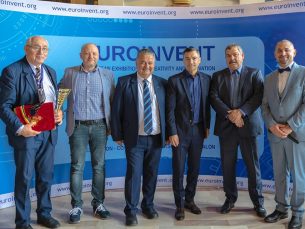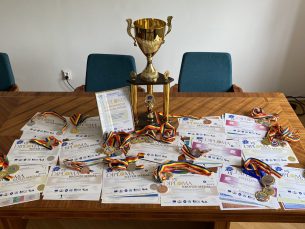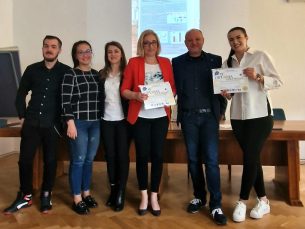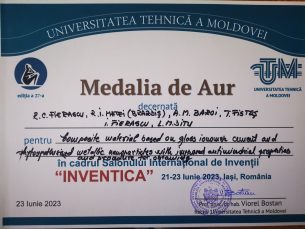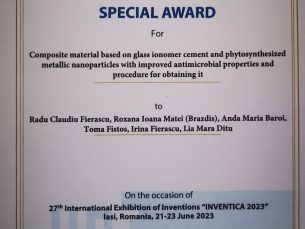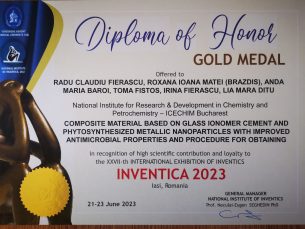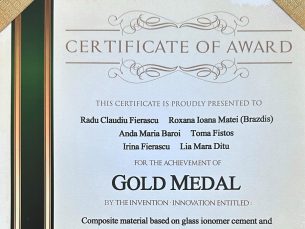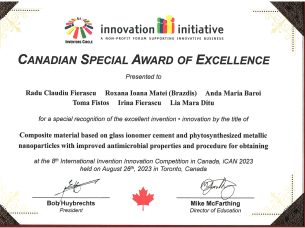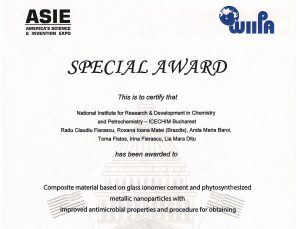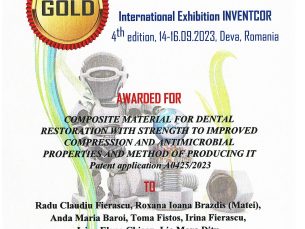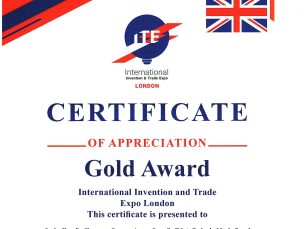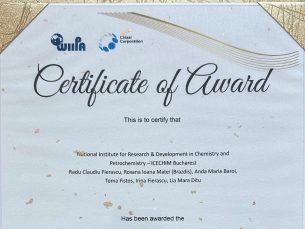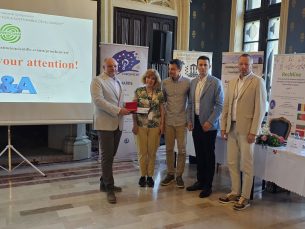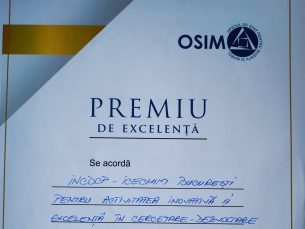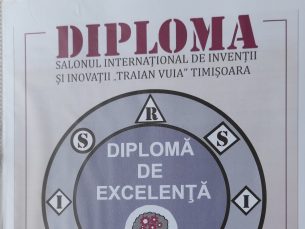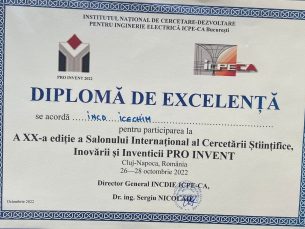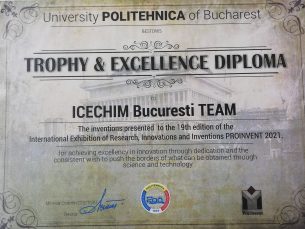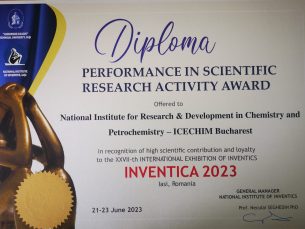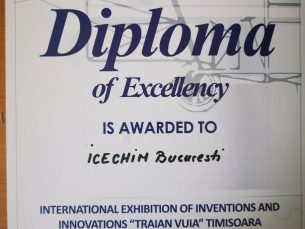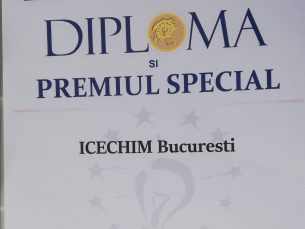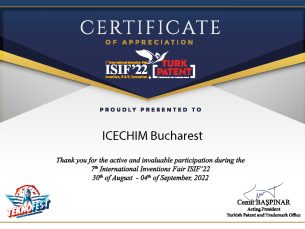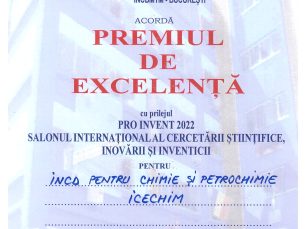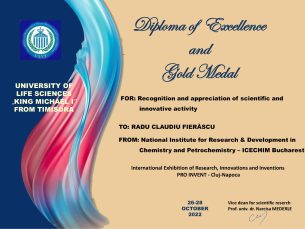Through nanotechnology towards the next generation dental restorative materials
NANODENT
PN-III-P4-PCE-2021-0292
(92PCE/2022)
The solution developed in the research project will lead to a completion of the teeth treatment through the possibility of having antibacterial properties and slow release after the cavity is closed, with enhanced mechanical properties.
Project goal
The main goal of the project is to propose a potential dental restorative material with simultaneous antibacterial properties and enhanced mechanical strength, based on substituted apatitic nanomaterials (decorated with metallic nanoparticles) and natural compounds, applicable in cement base (glass-ionomer cements).
Contracting authority: Executive Unit for Financing Higher Education, Research, Development and Innovation (UEFISCDI)
Implementation period: 09/05/2022-31/12/2024
Budget: 1.200.000 lei
Project director: Dr. Habil. Radu Claudiu Fierăscu
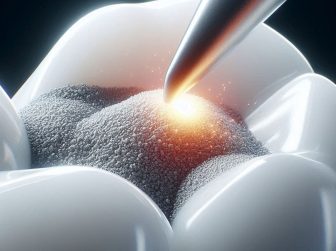
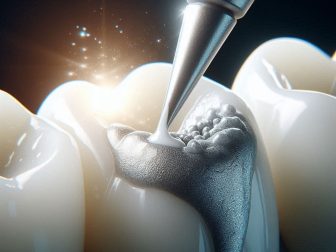
The scientific concept of the project is based on some specific logical steps:
S1. Synthesis of modified apatitic nanomaterials (MAN), substituted with different metals such as zinc, silver, titanium etc., and further decorated with mono or bimetallic phytosynthesized nanoparticles and metallic oxides nanoparticles (such as silver and silver oxide nanoparticles, zinc and zinc oxides nanoparticles, silver/zinc bimetallic nanoparticles, etc.), with controlled morphologies and properties;
S2. Demonstration of their enhanced properties;
S3. Enriching the MAN with natural compounds (commercially available polyphenols, such as eugenol, gallic acid, or catechin, for example) – NNC;
S4. Obtaining nanoparticle-based platforms (incorporation of apatitic materials enhanced with natural compounds in glass-ionomer cements – NGI);
S5. Demonstration of the enhanced properties of the obtained
nanoparticle-based platforms (NGI);
S6. Demonstration of their efficiency in the laboratory model (simulated conditions);
S7. Validation of the proposed solution.
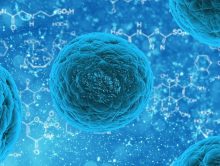
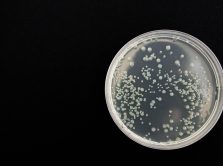
The main goal of the project is to propose a potential dental restorative material with simultaneous antibacterial properties and enhanced mechanical strength, based on substituted apatitic nanomaterials (decorated with metallic nanoparticles) and natural compounds, applicable in cement base (glass-ionomer cements). The degree of novelty of the proposed project emerges from the properties of the proposed material related with potential final application: simultaneous antibacterial and enhanced mechanical strength of the developed nanomaterials-based structures, applicable in the cement base (glass-ionomer cements).
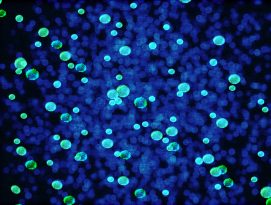
The specific objectives that will ensure the achievement of project aim are:
SO1. development of substituted apatitic materials with enhanced antimicrobial properties;
SO2. phytosynthesis of mono and bimetallic nanoparticles based on “green chemistry” approaches (with extracts obtained from autochthonous plants belonging to the Lamiaceae family – Thymus serpyllum L., 1753, Satureja hortensis L., 1753, Melissa officinalis L., Mentha spicata L., etc.) and their application for the decoration of the apatitic materials, in order to obtain modified apatitic nanomaterials (MAN) with enhanced antimicrobial properties
SO3. enrichment of the MAN with natural compounds (NNC)
SO4.incorporation of NNC in glass-ionomer cements and the demonstration of their efficiency
Development of apatitic nanostructures with potential use in improving current dental restorative materials.
Deployment period: 09/05/2022 – 31/12/2022
Activities:
- Synthesis and characterization of apatitic materials
- Assessing the possibilities of incorporating modified apatitic nanomaterials (MAN) into glass ionomer cements
- Assessment of antimicrobial properties and biocompatibility of apatitic nanomaterials – Part I
- Synthesis and characterization of phytosynthesized metallic and bimetallic nanoparticles
- Evaluation of the antimicrobial properties of phytosynthesized NPs
- Dissemination of results and project;
Optimizing the decoration of apatitic materials. Enrichment of apatitic materials modified with natural compounds – part I.
Deployment period: 01/01/2023 – 31/12/2023
Activities:
- Evaluation of antimicrobial properties of phytosynthesized nanoparticles – Part II
- Assessment of antimicrobial properties and biocompatibility of apatitic nanomaterials – Part II
- Evaluation of the mechanical properties of new apatitic materials
- Optimization of apatitic materials taking into account their morphologies, antimicrobial, mechanical properties and biocompatibility
- Optimization of phytosynthesys parameters and decoration of apathetic nanomaterials for the development of modified apatitic nanomaterials (MAN).
- Optimizing the decoration of apatitic materials with phytosynthesized nanoparticles to achieve optimal properties
- Obtaining and characterizing MANs enriched with natural compounds
- Dissemination of results and project
Enrichment of apatitic materials modified with natural compounds – part II. Incorporation of modified apatitic materials enhanced with natural compounds in glass ionomer cements (for obtaining platforms based on nanomaterials – NGI) and study of their influence on the mechanical properties of GIC. Demonstration and validation of the improved properties of the obtained NGIs.
Deployment period: 01/01/2024 – 31/12/2024
Activities:
- Evaluation of antimicrobial effects and biocompatibility of MAN enriched with natural compounds
- Evaluation of the mechanical properties of apatitic materials enriched with natural compounds
- Obtaining and characterizing glass ionomer cements based on nanomaterials enriched with natural compounds (NGI) with improved mechanical properties.
- Evaluation of the release of active compounds under conditions similar to real ones (synthetic saliva solutions).
- Evaluation of antibacterial effects and biocompatibility under conditions similar to real ones (synthetic saliva solutions)
- Evaluation of mechanical properties, adhesion and thermal insulation properties in conditions similar to real ones (synthetic saliva solutions); validation of the proposed solution
- Development of technical documentation for technology and products and patent applications
- Dissemination of results and project
- at least 8 published articles in Q1/Q2 scientific journals, preferably open-access publications
- at least 10 participations at international conference
- at least 6 participations at inventions exhibitions,
- publication of a book/ book chapter on the project topic at a foreign publication house;
- workshop
- at least two patent applications
- Ungureanu, C.; Fierascu, I.; Fierascu, R.C. Sustainable Use of Cruciferous Wastes in Nanotechnological Applications. Coatings 2022, 12, 769. https://doi.org/10.3390/coatings12060769
- Fierascu, I.C.; Fierascu, I.; Baroi, A.M.; Ungureanu, C.; Ortan, A.; Avramescu, S.M.; Somoghi, R.; Fierascu, R.C.; Dinu-Parvu, C.E. Phytosynthesis of Biological Active Silver Nanoparticles Using Echinacea purpurea L. Extracts. Materials 2022, 15, 7327. https://doi.org/10.3390/ma15207327
- Fierascu, R.C. Incorporation of Nanomaterials in Glass Ionomer Cements—Recent Developments and Future Perspectives: A Narrative Review. Nanomaterials 2022, 12, 3827. https://doi.org/10.3390/nano12213827
- Baroi, A.M.; Sieniawska, E.; Świątek, Ł.; Fierascu, I. Grape Waste Materials—An Attractive Source for Developing Nanomaterials with Versatile Applications. Nanomaterials 2023, 13, 836. https://doi.org/10.3390/nano13050836
- Velescu, B.Ș.; Ilie, M.I.; Amzăr, A.I.; Lupașcu, R.E.; Marandiuc, I.M.; Apetroaei, M.-M.; Arsene, A.L.; Blejan, E.I.; Nedea, O.A.; Fistos, T.; Fierăscu, R.C.; Bărbuceanu, F.; Țoca, C.; Fierăscu, I.; Udeanu, D.I.; Ghica, M.; Drăgănescu, D.; Cobelschi, P.C. Development and Experimental Evaluation of Some Silver Nanoparticles with Antimicrobial Potential. Processes 2023, 11, 1212. https://doi.org/10.3390/pr11041212
- Fierascu, I.C.; Fierascu, I.; Baroi, A.M.; Ungureanu, C.; Spinu, S.; Avramescu, S.M.; Somoghi, R.; Fierascu, R.C.; Dinu-Parvu, C.E. Phytosynthesis of Silver Nanoparticles Using Leonurus cardiaca L. Extracts. Materials 2023, 16, 3472. https://doi.org/10.3390/ma16093472
- Șuică-Bunghez, I.R.; Senin, R.M.; Sorescu, A.A.; Ganciarov, M.; Răut, I.; Firincă, C.; Constantin, M.; Gifu, I.C.; Stoica, R.; Fierăscu, I.; et al. Application of Lavandula angustifolia Mill. Extracts for the Phytosynthesis of Silver Nanoparticles: Characterization and Biomedical Potential. Plants 2024, 13, 333. https://doi.org/10.3390/plants13030333
- Lupuliasa, A.I.; Baroi, A.-M.; Avramescu, S.M.; Vasile, B.S.; Prisada, R.M.; Fierascu, R.C.; Fierascu, I.; Sărdărescu, D.I.; Ripszky Totan, A.; Voicu-Bălășea, B.; et al. Application of Common Culinary Herbs for the Development of Bioactive Materials. Plants 2024, 13, 997. https://doi.org/10.3390/plants13070997
- Lupuliasa, A.I.; Prisada, R.M.; Matei, R.I.; Avramescu, S.M.; Vasile, B.Ș.; Fierascu, R.C.; Fierascu, I.; Voicu-Bălașea, B.; Meleșcanu Imre, M.; Pițuru, S.-M.; et al. Development of Biologically Active Phytosynthesized Silver Nanoparticles Using Marrubium vulgare L. Extracts: Applications and Cytotoxicity Studies. Nanomaterials 2024, 14, 895. https://doi.org/10.3390/nano14100895
- The International Symposium “priorities of chemistry for a sustainable development” PRIOCHEM – XVIII-th Edition. October 26-28, 2022, Development of phytosynthesized nanoparticles with enhanced biological properties, Ioana Cătălina Fierăscu, Irina Fierăscu, Anda Maria Baroi, Camelia Ungureanu, Alina Orțan, Simona Spinu, Sorin Marius Avramescu, Raluca Șomoghi, Radu Claudiu Fierăscu, Valetina Anuta, Cristina Elena Dinu-Pârvu
- Physics of Materials – PM 7 2022, At the Frontier Between Materials Science and Biotechnology: Nanomaterials Phytosynthesis, I. Fierascu, R.C. Fierascu, A.M. Baroi, R.I. Matei (Brazdis), T. Fistos, I.C. Fierascu, I. Chican, I.S. Hosu (Invited lecture)
- International Scientific Symposium CURRENT TRENDS IN NATURAL SCIENCES 2023, From nature to nanotechnology: nanomaterials phytosynthesis, Irina Fierascu, Radu Claudiu Fierascu, Anda Maria Baroi, Roxana Ioana Matei (Brazdis), Toma Fistos, Ioana Catalina Fierascu, Irina Chican, Ioana Silvia Hosu (invited key-note lecture)
- 5th International Conference on Natural Products Utilization: From Plants to Pharmacy Shelf – ICNPU, May 30-02 June 2023, Bulgaria, Natural compounds from grape wastes for pharmaceutics and cosmetic formulations, Anda Maria Baroi, Monica Florentina Raduly, Ioana Silvia Hosu, Bogdan Trica, Roxana Ioana Brazdis (Matei), Toma Fistos, Radu Claudiu Fierăscu, Irina Fierăscu
- Application of electron microscopy in the characterization of phytosynthesized nanoparticles, Radu Claudiu Fierascu, Irina Fierascu, Anda Maria Baroi, Roxana Ioana Matei (Brazdis), Toma Fistos, Irina Chican, Ioana Silva Hosu, (invited lecture), Conferința Societății de Microscopie Electronică din România – C.R.E.M.S, 18-21 Octombrie 2023, Cluj Napoca.
- Application of nanotechnology for the development of a next generation dental restorative material, Radu Claudiu Fierascu, Anda Maria Baroi, Roxana Ioana Matei (Brazdis), Toma Fistos, Irina Fierascu, Ioana Silvia Hosu, Irina Elena Chican, Lia Mara Ditu, “Priorities of Chemistry for a Sustainable Development” PRIOCHEM XIXth Edition, 11-13 Octombrei 2023, Bucuresti, published as Fierascu, R.C.; Baroi, A.M.; Matei, R.I.; Fistos, T.; Fierascu, I.; Hosu, I.S.; Chican, I.E.; Ditu, L.M. Application of Nanotechnology for the Development of a Next Generation Dental Restorative Material. Proceedings 2023, 90, 13. https://doi.org/10.3390/proceedings2023090013
- Virtual International Scientific Conference on “Applications of Chemistry in Nanosciences and Biomaterials Engineering” NanoBioMat 2023 – Winter Edition, Total Concentration of Phenolic Compounds and the Antioxidant Activity of Grape Must after Treatment with Hydroalcoholic Extracts from Plant Waste Enhanced with Silver Nanoparticles, D.I. Toma (Sărdărescu), R.C. Fierăscu, D.E. Vizitiu, I. Fierăscu, A.M. Baroi, A. Din
- Radu Claudiu Fierascu, Phytonanotechnology – a multidisciplinary research area, International Conference “Agriculture for Life, Life for Agriculture“, 13th edition, 6-8 June 2024 (invited lecture).
- Roxana Ioana Matei (Brazdis), Anda Maria Baroi, Toma Fistos, Lia Mara Ditu, Irina Fierascu, Cristian-Andi Nicolae, Monica Florentina Raduly, Maria Grapin, Valentin Raditoiu, Radu Claudiu Fierascu, How can nanomaterials and nanotechnology advancements can find applicatoins in our veryday life, International Scientific Symposium CURRENT TRENDS IN NATURAL SCIENCES, 16 – 18 May 2024, National University of Science and Technology POLITEHNICA Bucharest, Pitesti University Centre, Romania
- Irina Fierascu, Radu Claudiu Fierascu, Daniela Toma (Sărdărescu), Anda Maria Baroi, Roxana Ioana Matei (Brazdis),Toma Fistos, Irina Elena Chican, Ioana Silvia Hosu, Lia Mara Dițu, Green Chemistry Nanomaterials for Increasing the Quality of Life, International Conference on Innovative Research, EUROINVENT, Iași, 6-7 June 2024.
- Irina Fierascu, Radu Claudiu Fierascu, Anda Maria Baroi, Roxana Ioana Matei (Brazdis),Toma Fistos, Irina Elena Chican, Ioana Silvia Hosu, Lia Mara Dițu, Apatitic materials for increasing the quality of life (Invited lecture), International Colloquium ‘Physics of Materials’ – PM-8, National University of Science and Technology POLITEHNICA Bucharest /Academy of Romanian Scientists, November 14-15, 2024 (invited lecture)
- Radu Claudiu Fierascu, Development of apatitic nanomaterials for increasing the quality of life, International Conference on Innovative Research, EUROINVENT, Iași, 6-7 June 2024 (invited lecture).
- Radu Claudiu Fierascu, Irina Fierascu, Anda Maria Baroi, Roxana Ioana Matei (Brazdis), Toma Fistos, Irina Elena Chican, Ioana Silvia Hosu, Lia Mara Ditu, Nanotechnology Approaches for the Development of Next-Generation Dental and Personal Care Products, 15th International Conference on Nanotechnology: Fundamentals and Applications, ICNFA 2024, August 25-27, 2024, Barcelona, Spain (Proceedings of the 10th World Congress on New Technologies – NewTech’24 -Barcelona, Spain – August 25-27, 2024, Paper No. ICNFA 101, DOI: 10.11159/icnfa24.101)
- Anda Maria Baroi, Irina Fierascu, Roxana Ioana Matei, Toma Fistos, Lia Mara Ditu, Ioana Silvia Hosu, Monica Florentina Raduly, Bogdan Trica, Radu Claudiu Fierascu, Procedure for the recovery of viticultural waste for the development of new spf cosmetic formulations, The International Symposium “PRIORITIES OF CHEMISTRY FOR A SUSTAINABLE DEVELOPMENT” 16-18 October 2024, Bucharest, Romania
- IDEA (IDEA, Novelty, Invention and craft) International Exhibition, Abony, Hungary – Through nanotechnology towards the next generation dental restorative materials (NanoDent) – Radu Claudiu Fierascu, Irina Fierascu, Anda Maria Baroi, Roxana Ioana Matei, Toma Fistos, Lia Mara Ditu (Gold medal)
- International Exhibition of Inventions and Innovations “TRAIAN VUIA – 2022 Timisoara – Through nanotechnology towards the next generation dental restorative materials (NanoDent) – Radu Claudiu Fierascu, Irina Fierascu, Anda Maria Baroi, Roxana Ioana Matei, Toma Fistos, Lia Mara Ditu (Bronze medal)
- 7th International Inventions Fair – ISIF’22 – Through nanotechnology towards the next generation dental restorative materials (NanoDent) – Radu Claudiu Fierascu, Irina Fierascu, Anda Maria Baroi, Roxana Ioana Matei, Toma Fistos, Lia Mara Ditu (Silver medal)
- EUROINVENT 2023 – Composite material based on glass ionomer cement and phytosynthesized metallic nanoparticles with improved antimicrobial properties and procedure for obtaining – Radu Claudiu Fierascu, Roxana Ioana Matei (Brazdis), Anda Maria Baroi, Toma Fistos, Irina Fierascu, Lia Mara Ditu (Gold medal, excellence diploma – The Nicolae Testemițanu State University of Medicine and Pharmacy – Republic of Moldova, Diploma of Recognition – University of Life Sciences ‘King Mihai I” from Timisoara, Creative Award – National Center for Scientific Research for Food Safety, special delegation award – ICPE-CA, EUROINVENT Grand Award)
- INVENTICA 2023 – Composite material based on glass ionomer cement and phytosynthesized metallic nanoparticles with improved antimicrobial properties and procedure for obtaining – Radu Claudiu Fierascu, Roxana Ioana Matei (Brazdis), Anda Maria Baroi, Toma Fistos, Irina Fierascu, Lia Mara Ditu (Gold medal, Special Award – University Politehnica of Timisoara, Gold medal – Moldova Technical University)
- International Exhibition Traian Vuia 2023, Timisoara – Composite material based on glass ionomer cement and phytosynthesized metallic nanoparticles with improved antimicrobial properties and procedure for obtaining – Radu Claudiu Fierascu, Roxana Ioana Matei (Brazdis), Anda Maria Baroi, Toma Fistos, Irina Fierascu, Lia Mara Ditu (Silver medal, Special Award – University Politehnica of Timisoara)
- INNOVERSE Innovation & Invention Expo 28-29 August 2023, Georgia Gwinnett, GA, USA, Composite material based on glass ionomer cement and phytosynthesized metallic nanoparticles with improved antimicrobial properties and procedure for obtaining – R.C. Fierascu, R.I. Matei (Brazdis), A.M. Baroi, T. Fistos, I. Fierascu, L.M. Ditu, Special Award – AZSCIENCES Science & Technology Center, Certificate of Achievement & Gold Medal
- JAPAN Design, Idea & Invention Expo, 6-8 Iulie, 2023, Composite material based on glass ionomer cement and phytosynthesized metallic nanoparticles with improved antimicrobial properties and procedure for obtaining – R.C. Fierascu, R.I. Matei (Brazdis), A.M. Baroi, T. Fistos, I. Fierascu, L.M. Ditu, Certificate of Award and Gold Medal
- The 8th International Invention Innovation Competition in Canada iCAN 2023, Toronto, Canada, 26 August 2023, Composite material based on glass ionomer cement and phytosynthesized metallic nanoparticles with improved antimicrobial properties and procedure for obtaining – R.C. Fierascu, R.I. Matei (Brazdis), A.M. Baroi, T. Fistos, I. Fierascu, L.M. Ditu, Certificate of Award and Gold Medal, Canadian Special Award of Excellence – Innovation Initiative Co-operative Inc. “Inventors Circle”
- INOVA, Zagreb, Croatia, 28 September 2023, Composite material based on glass ionomer cement and phytosynthesized metallic nanoparticles with improved antimicrobial properties and procedure for obtaining – R.C. Fierascu, R.I. Matei (Brazdis), A.M. Baroi, T. Fistos, I. Fierascu, L.M. Ditu, Gold Medal
- International Salon INVENTCOR 2023, 14-16 september 2023, Deva, Romania, Composite material based on glass ionomer cement and phytosynthesized metallic nanoparticles with improved antimicrobial properties and procedure for obtaining – R.C. Fierascu, R.I. Matei (Brazdis), A.M. Baroi, T. Fistos, I. Fierascu, L.M. Ditu, Diploma and Gold Medal, WIIPA Special Award – WIIPA, Special Award – Satit Chula Innovation Society, Thailand
- International Salon INVENTCOR 2023, 14-16 september 2023, Deva, Romania , Composite material for dental restoration with improved compression strength and antimicrobial properties and method of producing it – A0425/2023 – R.C. Fierascu, R.I. Matei (Brazdis), A.M. Baroi, T. Fistos, I. Fierascu, I.E. Chican, L.M. Ditu, Diploma and Gold Medal, Diploma – Inventarium Science
- ITE International Invention & Trade Expo London, 5-6 October 2023, Composite material for dental restoration with improved compression strength and antimicrobial properties and method of producing it – A0425/2023 – R.C. Fierascu, R.I. Matei (Brazdis), A.M. Baroi, T. Fistos, I. Fierascu, I.E. Chican, L.M. Ditu, Certificate of appreciation and Gold Award
- PROINVENT 2023, Cluj-Napoca 25-27 October 2023, Composite material based on glass ionomer cement and phytosynthesized metallic nanoparticles with improved antimicrobial properties and procedure for obtaining – R.C. Fierascu, R.I. Matei (Brazdis), A.M. Baroi, T. Fistos, I. Fierascu, L.M. Ditu, Excellence Diploma and Gold Medal
- PROINVENT 2023, Cluj-Napoca 25-27 Octombrie 2023, Composite material for dental restoration with improved compression strength and antimicrobial properties and method of producing it – A0425/2023 – R.C. Fierascu, R.I. Matei (Brazdis), A.M. Baroi, T. Fistos, I. Fierascu, I.E. Chican, L.M. Ditu, Excellence Diploma and Gold Medal
- 2023 Kaohsiung International Invention and Design EXPO (KIDE), 30.11-02.12.2023 Composite material for dental restoration with improved compression strength and antimicrobial properties and method of producing it, R.C. Fierascu, R.I. Brazdis (Matei), A.M. Baroi, T. Fistos, I. Fierascu, I.E. Chican,L.M. Ditu, Gold Medal
- Salonul International de Inventii si Inovatii Traian Vuia Timisoara 2024, Composite material for dental restoration with increased compression strength and antimicrobial properties and procedure for obtaining it, Radu Claudiu Fierascu, Roxana Ioana Brazdis (Matei), Anda Maria Baroi, Toma Fistos, Irina Fierascu, Irina Elena Chican, Lia Mara Ditu, Gold Medal
- EUROINVENT, 16th European Exhibition of Creativity and Innovation, Iasi, Romania, 6-8 June 2024, Composite material for dental restoration with increased compression strength and antimicrobial properties and method of producing it, Radu Claudiu Fierascu, Roxana Ioana Brazdis (Matei), Anda Maria Baroi, Toma Fistos, Irina Fierascu, Irina Elena Chican, Lia Mara Ditu, Gold Medal
- The 28th International Exhibition of Inventions “INVENTICA 2024” Iasi, Romania, Composite material for dental restoration with increased compression strength and antimicrobial properties and method of producing it, Radu Claudiu Fierascu, Roxana Ioana Brazdis (Matei), Anda Maria Baroi, Toma Fistos, Irina Fierascu, Irina Elena Chican, Lia Mara Ditu, Gold Medal
- Festivalul International de Inovare si Transfer Tehnologic innoCENTA, 7-8 Noiembrie 2024, Timisoara, Romania, Composite material for dental restoration with increased compression strength and antimicrobial properties and procedure for obtaining it, Radu Claudiu Fierascu, Roxana Ioana Brazdis (Matei), Anda Maria Baroi, Toma Fistos, Irina Fierascu, Irina Elena Chican, Lia Mara Ditu, Premiul Special CITT – U. Politehnica Timisoara, Diploma de Excelenta ICPE-CA Bucuresti
- The 9th International Invention Innovation Competition in Canada iCAN 2024, Toronto, Canada, 24 August 2024, Composite material for dental restoration with increased compression strength and antimicrobial properties and procedure for obtaining it, Radu Claudiu Fierascu, Roxana Ioana Brazdis (Matei), Anda Maria Baroi, Toma Fistos, Irina Fierascu, Irina Elena Chican, Lia Mara Ditu, Gold medal
- Kaohsiung Invention and Design Exposition · Kaohsiung Exhibition Centre, Taiwan · 5 – 7 December 2024, Composite material based on glass ionomer cement and phytosynthesized metallic nanoparticles with improved antimicrobial properties and procedure for obtaining – R.C. Fierascu, R.I. Matei (Brazdis), A.M. Baroi, T. Fistos, I. Fierascu, L.M. Ditu
- Macao International Innovation and Invention Expo (MiiEX 2024). 2024 25-27 October, Composite material for dental restoration with increased compression strength and antimicrobial properties and procedure for obtaining it, Radu Claudiu Fierascu, Roxana Ioana Brazdis (Matei), Anda Maria Baroi, Toma Fistos, Irina Fierascu, Irina Elena Chican, Lia Mara Ditu, Gold medal
- INOVA 2024, 48th International Invention Show, October 16-19, 2024, Zagreb, Croatia, Composite material based on glass ionomer cement and phytosynthesized metallic nanoparticles with improved antimicrobial properties and procedure for obtaining – R.C. Fierascu, R.I. Matei (Brazdis), A.M. Baroi, T. Fistos, I. Fierascu, L.M. Ditu, Gold Medal
- 1st edition of the EURO POLITEHNICUS International Exhibition of Innovation and Invention Show, 22-24 November 2024, National University of Science and Technology POLITEHNICA Bucharest, Composite material for dental restoration with increased compression strength and antimicrobial properties and procedure for obtaining it, Radu Claudiu Fierascu, Roxana Ioana Brazdis (Matei), Anda Maria Baroi, Toma Fistos, Irina Fierascu, Irina Elena Chican, Lia Mara Ditu, Gold medal, OSIM Excellence Award, Special Award from University Politehnica Timisoara for Radu Claudiu Fierascu, “Thoma Ionescu” Innovation Award from “Carol Davila” University of Medicine and Pharmacy
Institutional & personal awards
- Fierascu, I., Baroi, A.M., Fistos, T., Brazdis, R.I., Sardarescu (Toma), I.D., Fierascu, R.C. (2022). Bryophytes and the Nanotechnology: Recent Developments and Perspectives. In: Murthy, H.N. (eds) Bioactive Compounds in Bryophytes and Pteridophytes. Reference Series in Phytochemistry. Springer, Cham. https://doi.org/10.1007/978-3-030-97415-2_29-1
- Nanotechnology and nanomaterials for dental applications, within The International Symposium “Priorities of Chemistry for a Sustainable Development” PRIOCHEM XIXth Edition, 11-13 Octombrie 2023, Bucuresti, over 20 participants, Book of Abstracts (pag 70), ISSN 2601 – 419X and ISSN-L 2601 – 4181 – English ed., CD-ROM, other Electronic Supports.
- Nanotechnology-based dental materials, within The International Symposium “Priorities of Chemistry for a Sustainable Development” PRIOCHEM XXth Edition, 16-18 October 2024, Bucharest, over 25 participants.
- Radu Claudiu Fierascu, Roxana Ioana Brazdis (Matei), Anda Maria Baroi, Toma Fistos, Irina Fierascu, Lia Mara Ditu, Composite material based on glass ionomer cement and phytosynthesized metallic nanoparticles with improved antimicrobial properties and procedure for obtaining, Patent application A00104/2023
- Radu Claudiu Fierascu, Roxana Ioana Brazdis (Matei), Anda Maria Baroi, Toma Fistos, Irina Fierascu, Irina Elena Chican, Lia Mara Ditu, Composite material for dental restoration with improved compression strength and antimicrobial properties and method of producing it, Patent application A00425/2023
- Radu Claudiu Fierascu, Roxana Ioana Brazdis (Matei), Irina Fierascu, Toma Fistos, Anda Maria Baroi, Lia Mara Ditu, Composite material for dental restoration based on metal oxide nanoparticles and phosphate material with improved antimicrobial properties and method of obtaining it, A00727/2024
Summary
Acidic attack by cariogenic bacteria associated with plaque biofilm development is responsible for dental caries, a biofilm-dependent infectious disease that damages teeth through mineral loss and has a high incidence of the use of polymers for clinical restoration. The complexity of oral biofilms contributes to the difficulty of developing new effective dental materials. The oral cavity is an ideal environment for microbial cell growth, persistence and plaque formation.
The presence of different microniches leads to the appearance of different biofilm communities, formed on the surface of the teeth, above the gingival crevice or at the subgingival level, on the tongue, mucous membranes or on dental prosthetic materials. In this context, nanotechnology has the potential to be explored in the development of bioactive dental materials to reduce or modulate the activities of caries-related bacteria. The main goal of the project is to propose a potential dental restorative material with antibacterial properties simultaneously with increased mechanical resistance, based on substituted apatitic nanomaterials (decorated with metal nanoparticles) and natural compounds, applicable in glass ionomer cements. The project proposal responds to a real practical demand arising from discussions with the dental community.
The degree of novelty of the proposed project emerges from the properties of the proposed material related to the potential final application: improved mechanical resistance and simultaneous antibacterial activity of the structures developed based on nanomaterials, applicable in glass ionomer cements.
The activities planned to be carried out during the first year of implementation were:
- Act. 1.1. Synthesis and characterization of apatite materials
- Act. 1.2. Evaluation of the possibilities of incorporating modified apatite nanomaterials (NAM) in glass ionomer cements
- Act. 1.3. Evaluation of antimicrobial properties and biocompatibility of apatitic nanomaterials – Part I
- Act. 1.4. Synthesis and characterization of phytosynthesized metallic and bimetallic nanoparticles
- Act. 1.5. Evaluation of antimicrobial properties of phytosynthesized nanoparticles – Part I
- Act. 1.6. Dissemination of the results and the project.
The proposed activities were carried out in full, supporting the continuation of the project in the year 2023. Thus, they identified the possibilities of incorporating different types of target materials (apatitic materials, nanoparticles, etc.) and both apatitic materials and phytosynthesized metal nanoparticles were developed and studied .
The obtained results were disseminated within the scientific community, the results of the dissemination being widely presented on the project website (Romanian version – https://icechim.ro/project/nanodent/, English version – https:// icechim.ro/project/nanodent_en/), but also through the weekly Newsletter of the Ministry of Research, Innovation and Digitalization.
No | Estimated results | Obtained results |
|---|---|---|
1 | Preliminary report on the development of modified apatite nanomaterials (NAM); | The preliminary report on the possibilities to develop modified apatite nanomaterials was performed, synthesizing and characterizing a series of modified apatite materials |
2 | Report on the possibilities of incorporating the developed nanomaterials into glass ionomer cements | The report on the modification of glass ionomer cements with nanomaterials was elaborated (published as a review paper) |
3 | Preliminary report on the antimicrobial properties of apatite nanomaterials | The preliminary report on the antimicrobial properties of the obtained apatite materials was elaborated |
4 | Report on the antimicrobial properties of phytosynthesized NP | The report on the antimicrobials properties of phytosynthesized NPs was elaborated (published as two ISI articles) |
5 | Submission for publication of at least two ISI articles in Q1/Q2 journals | Three ISI articles were published in Q1/Q2 journals |
6 | Participation in at least one scientific event | Two participations in international scientific events were recorded |
7 | Participation in at least 1 invention salon | Three participations in invention salons were recorded, obtaining a series of prizes, presented on the project website |
8 | Project web page and online campaign on social media | The project website was developed, both in Romanian and in English; of the project was disseminated through social media, but also through MCID’s weekly Newsletter |
Summary
Acidic attack by cariogenic bacteria associated with plaque biofilm development is responsible for dental caries, a biofilm-dependent infectious disease that damages teeth through mineral loss and has a high incidence of the use of polymers for clinical restoration. The complexity of oral biofilms contributes to the difficulty of developing new effective dental materials. The oral cavity is an ideal environment for microbial cell growth, persistence and plaque formation. The presence of different microniches leads to the appearance of different biofilm communities, formed on the surface of the teeth, above the gingival crevice or at the subgingival level, on the tongue, mucous membranes or on dental prosthetic materials.
In this context, nanotechnology has the potential to be explored in the development of bioactive dental materials to reduce or modulate the activities of caries-related bacteria. The main goal of the project is to propose a potential dental restoration material with antibacterial properties simultaneously with increased mechanical resistance, based on substituted apatitic nanomaterials (decorated with metal nanoparticles) and natural compounds, applicable in glass ionomer cements. The degree of novelty of the proposed project emerges from the properties of the proposed material related to the potential final application: improved mechanical resistance and simultaneous antibacterial activity of the structures developed based on nanomaterials, applicable in glass ionomer cements.
The activities planned to be carried out during the second stage of the project were:
- A.2.1. Evaluation of antimicrobial properties of phytosynthesized nanoparticles – Part II
- A.2.2. Evaluation of antimicrobial properties and biocompatibility of apatitic nanomaterials – Part II
- A.2.3. Evaluation of the mechanical properties of new apatite materials
- A.2.4. Optimization of apatitic materials considering their morphologies, antimicrobial, mechanical properties and biocompatibility
- A.2.5. Optimization of phytosynthesis parameters and decoration of apatite nanomaterials for the development of modified apatite nanomaterials (MAN).
- A.2.6. Optimizing the decoration of apatitic materials with phytosynthesized nanoparticles to achieve optimal properties
- A.2.7. Obtaining and characterization of MAN enriched with natural compounds
- A.2.8. Dissemination of the results and the project.
The proposed activities were carried out in full, supporting the continuation of the project in the year 2024. Thus, the activities related to the synthesis and optimization of the synthesis of apatitic nanomaterials, as well as phytosynthesized nanoparticles were continued, the modified apatitic materials enriched with natural compounds were obtained and tested from an antimicrobial point of view natural, thus offering real possibilities to put the developed solutions into practice.
The obtained results were disseminated within the scientific community, the results of the dissemination being widely presented on the project website (Romanian version – https://icechim.ro/project/nanodent/, English version – https:// icechim.ro/project/nanodent_en/).
No | Estimated results | Obtained results |
|---|---|---|
1 | Final report on the development of modified apatite nanomaterials (MAN) | The final report on the development of modified apatitic nanomaterials was elaborated |
2 | Final Report on Antimicrobial Properties of Apatitic Nanomaterials | The final report on the antimicrobial properties of apatitic nanomaterials was elaborated |
3 | Final report on the antimicrobial properties of NP | The final report on the antimicrobial properties of the NPs was developed |
4 | MAN optimization report | The MAN optimization report was developed |
5 | Preliminary report on the development of modified apatitic nanomaterials enriched with natural compounds | The preliminary report on the development of modified apatitic nanomaterials enriched with natural compounds was elaborated |
6 | Submission for publication of at least three ISI articles in Q1/Q2 journals | Three ISI articles were published in Q1/Q2 journals (reaching a total of 6 articles published out of 8 proposed for the entire project) |
7 | Participation in at least five scientific events | Five participations in international scientific events were recorded (reaching a total of 7 participations out of 10 proposed for the entire project) |
8 | Participation in at least 3 invention exhibitions | Thirteen participations in invention exhibitions were registered, obtaining a series of awards, presented on the project website (indicator exceeded considering the level proposed for the entire project) |
9 | Updating the project web page and continuing the online campaign on social media | The project website, both in Romanian and in English, has been continuously updated; the project was disseminated through social media |
10 | Other activities | Other activities were also carried out: – Workshop organization (indicator accomplished 100% at project level) – Presenting an invited talk in a foreign laboratory on the project’s topic – Submission of two patent applications (100% completed indicator at the project level) – Publication of a book chapter (indicator achieved 100% at the project level) |
Summary
Acidic attack by cariogenic bacteria associated with plaque biofilm development is responsible for dental caries, a biofilm-dependent infectious disease that damages teeth through mineral loss and has a high incidence of the use of polymers for clinical restoration. The complexity of oral biofilms contributes to the difficulty of developing new effective dental materials. The oral cavity is an ideal environment for microbial cell growth, persistence and plaque formation. The presence of different microniches leads to the appearance of different biofilm communities, formed on the surface of the teeth, above the gingival crevice or at the subgingival level, on the tongue, mucous membranes or on dental prosthetic materials. In this context, nanotechnology has the potential to be explored in the development of bioactive dental materials to reduce or modulate the activities of caries-related bacteria. The main goal of the project is to propose a potential dental restoration material with antibacterial properties simultaneously with increased mechanical resistance, based on substituted apatitic nanomaterials (decorated with metal nanoparticles) and natural compounds, applicable in glass ionomer cements. The degree of novelty of the proposed project emerges from the properties of the proposed material related to the potential final application: improved mechanical resistance and simultaneous antibacterial activity of the structures developed based on nanomaterials, applicable in glass ionomer cements.
The activities planned to be carried out during the third stage of the project were:
a. Act 3.1 – Evaluation of the antimicrobial effects and biocompatibility of NAM enriched with natural compounds
b. Act 3.2 – Evaluation of the mechanical characteristics of apatite materials enriched with natural compounds
c. Act 3.3 – Obtaining and characterizing glass ionomer cements based on nanomaterials enriched with natural compounds (NGI) with improved mechanical properties.
d. Act 3.4 – Evaluation of the antimicrobial properties and biocompatibility of NGI
e. Act 3.5 – Evaluation of the release of active compounds under conditions similar to real ones (synthetic saliva solutions).
f. Act 3.6 – Evaluation of antibacterial effects and biocompatibility under conditions similar to real ones (synthetic saliva solutions)
g. Act 3.7 – Evaluation of mechanical properties, adhesion and thermal insulation properties under conditions similar to real ones (synthetic saliva solutions); validation of the proposed solution
h. Act 3.8 – Development of technical documentation for technology and products and patent applications.
i. Act 3.9 – Dissemination of results and the project
The proposed activities were fully implemented, thus supporting the successful completion of the project. Thus, activities related to the synthesis and optimization of the phytosynthesis of nanoparticles were continued, the antimicrobial effects, biocompatibility and mechanical properties of apatitic nanomaterials enriched with natural compounds were evaluated, glass ionomer cements based on nanomaterials enriched with natural compounds with improved mechanical properties were obtained and characterized, their antimicrobial properties and biocompatibility were evaluated, as well as the evaluation of the release of active compounds, antibacterial effects and biocompatibility under conditions similar to real ones (in synthetic saliva solutions), and their mechanical properties, adhesion and thermal insulation properties. The proposed materials were validated by external laboratories. In addition, the technical documentation for the technology and products was developed and the work on the development of patent applications was completed.
During this stage, the dissemination activity of the project and of the obtained results was completed, with significant exceedances of most of the assumed indicators being recorded.
The results obtained were disseminated within the scientific community, the results of the dissemination being presented extensively on the project website (Romanian version – https://icechim.ro/project/nanodent/, English version – https://icechim.ro/project/nanodent_en/).
The accomplishment degree of estimated results
Estimated result | Obtained results | Accomplishment degree |
|---|---|---|
Final report on the development of modified apatite nanomaterials enriched with natural compounds; | The final report on the development of modified apatite nanomaterials was completed (chapters 1 and 2 of the phase scientific and technical report) | 100% |
Report on the development of platforms based on glass ionomer cements/nanomaterials enriched with natural compounds (NGI); | The report on the development of platforms based on glass ionomer cements/nanomaterials enriched with natural compounds (NGI) was completed (chapter 3 of the phase scientific and technical report) | 100% |
Report on NGI properties; | The report on NGI properties was completed (chapters 4-7 of the RST). External validation of the materials was completed by an independent laboratory (from a Medicine University) (chapter 7 of the phase scientific and technical report). | 100% |
Technical documentation for technology and products; | Technical documentation for technology and products was prepared (chapter 8 of the phase scientific and technical report) | 100% |
At least two patent applications (for the entire project period); | During phase III, one patent application was submitted. In total, three patent applications were submitted (chapter 9 of the phase scientific and technical report) | 150% |
1 workshop for presentation and promotion of the project and possible applications (for the entire project period) | During phase III, one workshop was organized. In total, two workshops were organized | 200% |
Publication of a book/book chapter by an international publishing house (for the entire project period) | One book chapter was published (reported in stage II) | 100% |
Submission for publication of at least eight ISI articles in Q1/Q2 journals (of which 3 in phase III) | Ten articles were submitted for publication in Q1 and Q2 journals, of which 9 were published (four in Q1 and 5 in Q2). In the third phase, four articles were submitted for publication/published. | 125% |
Participation in at least ten scientific events (of which at least four in phase III) | Participation in 14 scientific events was recorded (of which six as invited lectures); of these, seven were recorded in phase III | 140% |
Participation in at least six invention salons (of which at least 2 in phase III) | Participation in 25 invention salons was recorded (of which nine in stage III) | 417% |
The estimated impact of this project is considerable, with the potential to redefine current dental practices and bring major innovations in the field of dental restorative materials. The three patent applications filed reflect essential advances in the development of advanced composite materials, which combine nanotechnology with phytonanotechnology, offering multidimensional solutions to current clinical challenges.
The most significant result of the project is the development of dental restorative materials that incorporate both advanced nanotechnology and phytonanotechnology – an innovative branch that capitalizes on phytosynthesized metal nanoparticles (using natural extracts). These materials have been validated by independent laboratories, demonstrating an optimal combination of biocompatibility, improved antimicrobial activity and increased mechanical strength. These characteristics position the materials as revolutionary, with the potential to significantly reduce the risk of post-treatment infections, extend the lifespan of dental restorations and reduce the need for re-interventions.
This achievement not only opens up new perspectives for future research, but also has a direct impact on the quality of life of patients, offering them safer and more effective treatments. In addition, the use of phytonanotechnology contributes to sustainability by integrating natural resources into manufacturing processes, aligning with global trends to reduce the ecological impact of medical materials. Thus, our project demonstrates how fundamental and applied research can generate sustainable solutions, with profound implications in both the field of science and practical applications.
In addition, the project exceeded the assumed indicators regarding the contribution to the achievement of the program objectives, by:
a. Submission for publication of ten articles in Q1 (five) and Q2 (five) journals, in open-access mode, without costs associated with publication. Nine of these articles had been published at the time of writing the report, totaling 48 citations (SCOPUS), respectively 41 citations (WoS); assumed indicator: eight articles submitted for publication
b. Participation in fourteen scientific events, of which six were invited lectures (proof of the high visibility of the project director); assumed indicator: at least 10 participations in international conferences.
c. Participation in twenty-five events dedicated to invention and innovation (participations resulting in the awarding of an impressive number of awards, presented on the project website, including grand prizes of the exhibition or individual recognitions); assumed indicator: at least 6 participations in invention exhibitions.
d. Submission of three patent applications, proof of the high applicability of the results obtained; assumed indicator: at least two patent applications submitted.
e. Organization of two workshops to present the project and the results obtained; assumed indicator: organization of a workshop.
f. Publication of a book chapter at an international publishing house (Springer); assumed indicator: publication of a book/book chapter at an international publishing house;
g. Increasing the visibility of the researchers involved in the project. At the time of submitting the project, the research team had the following scientometric indicators (cumulative values): published papers – 522, citations – 4534, cumulative Hirsch index – 103. At the time of submitting this report, the scientometric indicators are as follows (cumulative values): published papers – 839, citations – 11727, cumulative Hirsch index – 163. Also, six papers presented as invited lectures (previously presented) and one visit as an invited professor were recorded.
h. Supporting young researchers: with the support of the project, three doctoral researchers publicly defended their doctoral theses (in September 2024).
